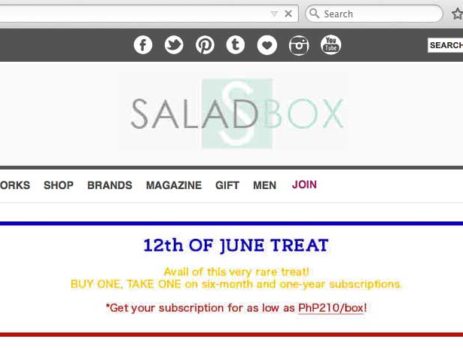Saladbox problems: are beauty box samples business sustainable?
Last Saturday at my E-Commerce Class in Cebu, I was giving a brief review on business models for new students as we gear up discussions on e-commerce site development. One of my students (let us call her “Kat”) subscribed to Saladbox after I shared it as a subscription-based e-commerce business model example. I asked if she noticed the Saladbox website update was still as of last April when I checked it last month. Although upon checking over the weekend, the campaigns was change up to June 12 with the same offer of 2 boxes per month for the subscription. Although the sign-up offerings now are limited.
Kat cited that she availed of a 3 months subscription (March if I recall correctly) and only got one box last April. She has been messaging Saladbox since May and only got a reply this June. She mentioned as well that there are a lot of complaints being posted by subscribers on their Facebook page.

It is sad to see Saladbox going through this challenge when I have fondly referred to them as an example in my e-commerce classes. It also brought to mind a question on what went wrong and is this business model sustainable?
The Beauty Box Business Model
When you look at Saladbox (including similar beauty boxes such as GlamourBox and BDJBox), their business model anchors on subscription where members are promised with free samples of interesting products within the price range that they availed of. This can include products for the hair, skin, beauty seminars, and treatments.
Most members subscribed for they love the idea of getting more than the amount they subscribed for (in terms of value). It gives them also the chance to try curated products and save the hassle of deciding whether it is a good one or not.
Once competition sets in though, the challenge begins as there will be more sources for beauty boxes and the pressure is there to offer products that are not being given by others and of higher quality.
Beauty box target market
As most beauty box providers have similar price points, it also draws direct comparison and most likely competing in the same market segment. For sustainability, it is important to identify or expand to other product and audience niche.
One must also be able to scale its supply chain for growth. Can you process 3000 box orders a month? Can you scale to 30,000 to 60,000 boxes a month?
Beauty box partners
Samples can come from a variety of sources. Some were provided for free and it is likely that some have purchased them too in bulk.
It is difficult to keep a “blue ocean” in this space as the business model is replicable.
Supply chain improvement may be the key but it would require its owners to invest in buying products in bulk and in advance to keep customers loyal and satisfied. Those who may be able to do so can invoke exclusivity.
Those who give free samples usually do so for marketing and hoping that those who liked their products will buy one. In worst case situations, some products may get a bad review from those who did not like it.
Those who gave free samples but did not experience any return in terms of sales will likely not give anymore in the future or consider other channels. The same can be said to those who gave huge discounts for their products.
It will be important to invest in product or service partners where regular feedback can be given. Also to partner with those who can scale as you grow. Collaboration can also be made to allow product or service partners build relationship with subscribers.
Option: Transform to Beauty Product Creator
In a meeting with a cosmetics manufacturer a few weeks back, we were discussing the free products he give on his website and how many have returned to actually purchase.
His advantage is that he is a cosmetics manufacturer. I showed him my favorite Heliocare foundation and asked how much will that cost if manufactured locally. The price point he gave made me realize it will be interesting to invest in cosmetics production.
Beauty box makers, in order to be sustainable, should also consider creating their own line. Taking advantage of their subscribers to do the initial product review and see which one can go for full production. Offering the same service as well to new product creators.
Although this is easier said than done as it would require immediately investing initial earnings into product creation. However, if you want to have a formidable brand in the long run, I believe it will all be worth it.
Keeping customers satisfied
Seeing complaints on the Saladbox Facebook page unanswered, it does not give a good sign on how the company is doing. When products are not delivered, the consumers are the one who lose as they have paid for them in advance – especially in a 3 or 6 or 1 year subscription plan. If delays are inevitable, beauty box makers should offer the option to refund right away rather than risk their reputation.










Leave a Reply